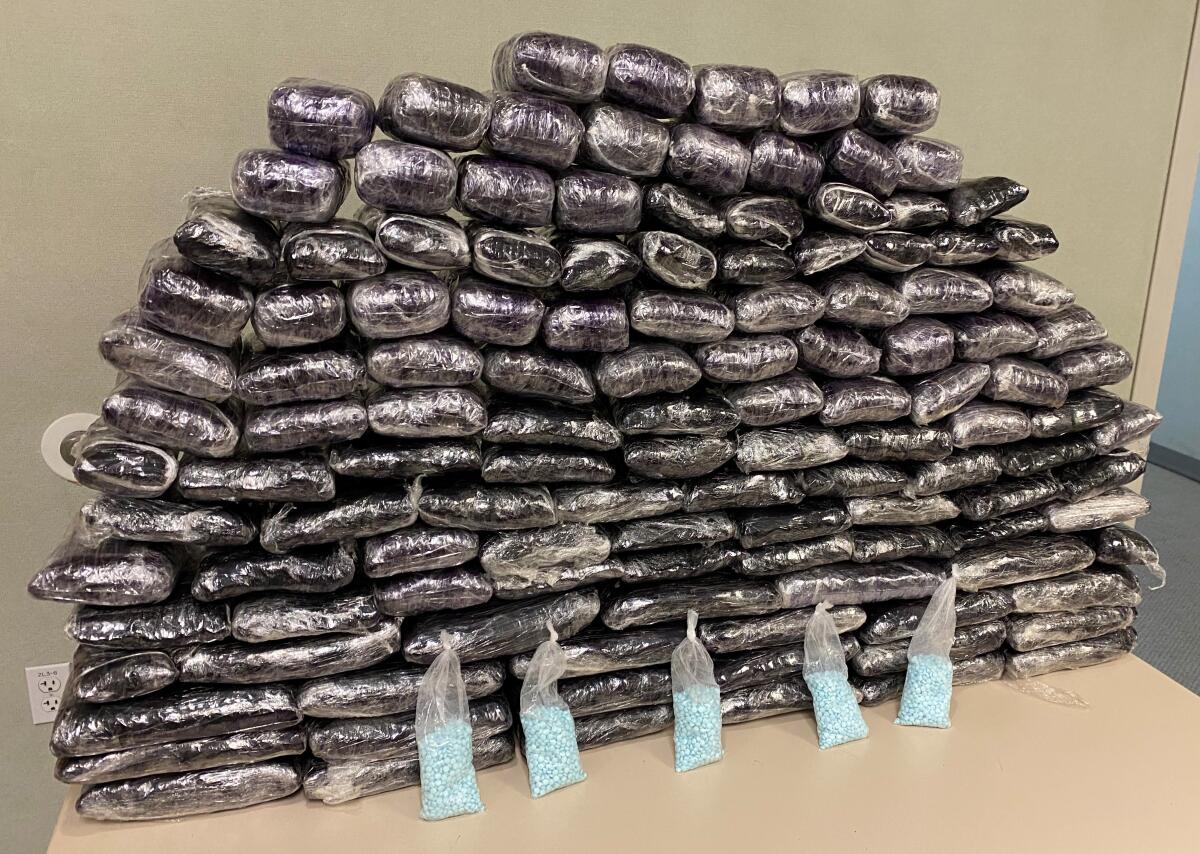Fentanyl pill seizures in L.A. region skyrocket

- Share via
Seizures of fentanyl-laced pills have more than quadrupled so far this year across four Southern California counties compared to last year, an increase that authorities said Tuesday underscores their efforts to keep pace with the continuing influx of the drug into the region.
At a meeting of the Los Angeles Police Commission, L.A. Police Department officials said that through September more than 904,000 pills containing the potent synthetic opioid that is more than 50 times stronger than heroin have been confiscated by regional task forces. The figure marked a sharp jump over the roughly 189,000 pills recovered by the task forces over the same period last year.
The seizures in Los Angeles., Riverside, Orange and San Bernardino counties were made during multiple operations by the region’s High Intensity Drug Trafficking Area task forces, which are overseen by federal authorities and target drug trafficking networks in Southern California. The program operates task forces in other parts of the country as well.
Authorities have had to adjust their tactics as Mexican cartels have shifted their smuggling efforts from cocaine to fentanyl, which offers significantly higher profit margins, LAPD Capt. Lillian Carranza told commissioners. A pill costs between 80 cents and $1.50 each to produce and is sold for $15 to $30 a pop on the streets of Los Angeles, officials said.
Thanks largely to its proximity to the southern border, airports and docks, the Los Angeles area has long been a major distribution hub for the shipment of illegal narcotics across the country, officials say. The pills are largely being made in labs in Mexico from chemicals shipped primarily from China, authorities say.
The 2022 figures presented Tuesday didn’t include hauls made in several recent drug stings, including one last month that netted more than 1 million fentanyl pills.
Such efforts have saved “many lives,” Carranza, who oversees the gang and narcotics division, said in a follow-up interview.
“I think we are making a dent, we are being successful, especially at the level that we operate, disrupting the distribution of these drugs by the Mexican cartels,” Carranza said. “I don’t think a seizure, for example of a million fentanyl pills is .... something that isn’t worth the effort.”
At the commission meeting Tuesday, LAPD Chief Michel Moore said the operations underscore the need for more action, citing recent statistics showing that drug overdoses were now the leading cause of death among people between the ages of 18 and 45.
“It’s not suicide, it’s not street violence — it’s the decision to take a chance on a pill,” he said.
Across Los Angeles County, fentanyl-related deaths, in particular, have continued to surge.
A report by the Los Angeles County medical examiner’s office concluded a “rapid increase in drug deaths was propelled primarily” by fentanyl, which in 2016 was a factor in 91 deaths. By 2020, that number had soared to 1,135.
Some experts caution that, while important, the recent high-profile seizures represent a drop in the bucket in the overall drug trade.
Chelsea Shover, assistant professor in residence in UCLA’s David Geffen School of Medicine, said that the problem needs to be looked at through a public health lens and that stepped-up actions by law enforcement “can’t be the only main strategy” for a crisis that predates the pandemic.
“Fentanyl pills are very cheap to make,” she said. “You can make a ton of them, so a large bust or a large seizure, while arguably important, represents only a fraction of what’s out there.”
As fentanyl-related overdoses continue to climb, Shover said, there is a need for more education about the deadly drug to counter “fear-mongering,” such as false warnings on social media in the lead-up to Halloween that drug dealers planned to give rainbow-colored fentanyl pills to kids as candy.
Shover said more also needs to be done to remove barriers to treatment, including access to medications such as methadone and buprenorphine, which are used to treat opioid addiction.
“People need to know without it being a scare-mongering thing that pills that one buys on the street are pretty likely to contain or are likely to be fentanyl,” Stover said.
More to Read
Sign up for Essential California
The most important California stories and recommendations in your inbox every morning.
You may occasionally receive promotional content from the Los Angeles Times.











